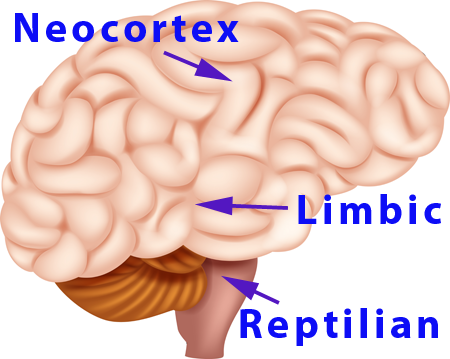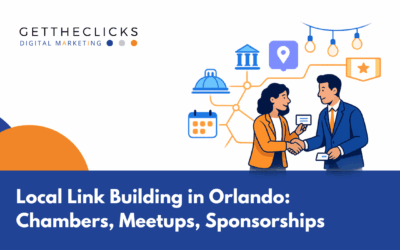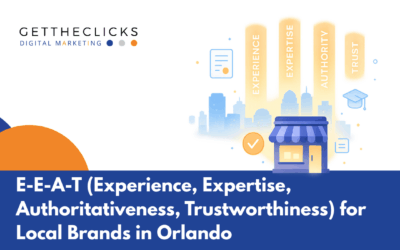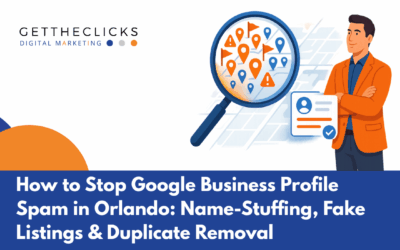Have you ever looked at your website and wondered, why aren’t more people contacting me? I can’t tell you the amount of times our Account Strategists have had discussions with clients about tactics to improve website performance. Many website owners spend too much time focusing on rank, and very little time determining if that rank is driving the right traffic.
Time and time again our Production Strategists determine that the recipe for the magic sauce to make your website roar is not found within your search engine rank, but within the way you deliver your message to your website audience.
After a rather non-productive meeting with a particular national client of ours, we decided to devote our next topic to this subject matter.
Websites & Wine Labels
Wine aisles can be intimidating to the uninitiated. Thousands of different bottles, hundreds of different winemakers, and dozens of varietals vie for our attention. But which one do we buy? A good way to narrow the options might be the easiest decision to make: white vs red? Let’s say red. So now we have narrowed the selection by several hundred. An auspicious start, surely. But now our decisions will diminish the massive field of choices by a smaller and smaller margin, and for those of us who cannot tell a Cabernet Sauvignon from a Cabernet Franc, a Chianti from a Sangiovese (I can’t), a difficult road still lies ahead. So how do we wine novices go about picking one bottle among hundreds? The simplest and surest answer: The label—the brainchild of a branding and marketing campaign designed to catch your attention in a sea of choices.
To be one among many, and how to distinguish yourself in a crowd, is the focus of Simon Sinek’s book, Start With Why: How Great Leaders Inspire Everyone to Take Action, a work he distilled into a 2010 TED talk. In his TED talk, Sinek asks why certain innovators and companies throughout history have had a more significant impact on the world than others and, in his discussion of business leaders, enjoyed a more sizable market share. He presents luminaries such as Martin Luther King Jr., the Wright brothers, and Steve Jobs with Apple as prime examples of leaders and companies who have made sizable contributions to public life and the world of business. He analyzes the traits shared by these innovators and leaders and provides us with a recipe for success in our own industries.
Put on Your Marketing Hat
As you continue to read, I want you to put your marketing hat on and think of the concept explained here in terms of your own website. Visitors who found your website need to be convinced that you can help them. You don’t want them looking at “other wine bottles”.
In Sinek’s TED talk, he asks: “So, why were the Wright brothers the first to achieve powered man flight? Why was Martin Luther King Jr. the primary leader of the Civil Rights Movement? And why, year after year, is Apple the most innovative company in the personal computing and electronics industry? What is different about these individuals and companies?”
The winners must differ in some important way from the innumerable other individuals and companies who worked toward the same goals, for, as Sinek tells us, “they were not without competition and were not particularly equipped for pre-determined success.”
He adds: “As to the Wright Brothers, there were certainly other teams who were better qualified, better funded—and they didn’t achieve powered man flight, and the Wright brothers beat them to it;” Martin Luther King Jr. “wasn’t the only man who suffered in pre-civil rights America, and he certainly wasn’t the only great orator of the day;” and Apple is, after all, “just a computer company. They’re just like everyone else. They have the same access to the same talent, the same agencies, the same consultants, the same media.” So, why, Sinek asks, do they all “seem to have something different?”
Conversions & The Golden Circle
There is a fundamental point of distinction in the way these companies, and individuals, approach the delivery of their message. Understanding how to Find your Voice and then hone your message can make all of the difference in the overall success of your website.
Sinek comes away from his analysis with the same interpretation many of us arrive at independently: “There’s something else at play here.” And after years of working on the problem, he thinks he knows just what that difference is:
“All of these individuals and organizations think, act, and communicate the exact same way.
And it’s the complete opposite to everyone else.”
Sinek says it’s the world’s simplest idea and that he has codified it. He calls it the Golden Circle, which opens the door for everyone to begin thinking the same way as the greatest innovators and leaders in history did. It provides every business, and its website, the chance to distinguish itself from all the others in its market place.
Sinek’s Golden Circle is a series of concentric circles revolving around the three questions that compose your business’s mission: Why? How? and What? Why is the core at center of the circle, surrounded by how and then finally what.
According to Sinek, every individual and business know what they do. Some know how they do it. But very few know why they do it, and why can make all the difference in your ability to achieve success and stand out in a crowded field of options and choices.
By why, Sinek means, “What’s your purpose? What’s your cause? What’s your belief? Why does your organization exist? Why do you get out of bed in the morning? And why should anyone care?” For Sinek, the why of your business, the principal at the heart of what and how you do something, is far more important in branding and marketing than what your product or service is or how you produce or carry it out. It defines what we might call Sinek’s Golden Rule:
“People don’t buy what you do; they buy why you do it. “
Meaning, if you talk about what you believe, you will attract those who believe what you believe.
The Why and Your Landing Page
Interpret this concept for a minute and think about it in terms of your landing page. Let’s not even worry about the rest of the pages. Just think of your landing page. In today’s fast-paced world, you don’t have a lot of time to convince a visitor that you are the best solution for their need, yet many websites present themselves in the same manner over and over again. There is no fundamental distinction. The procedure is simple. It goes something like this:
1. here is who we are
2. this is what we do
3. contact us.
In the above approach, the essence of what makes most people tick is completely lost. People often buy with emotion and then justify the purchase with logic. Think of your own buying behavior for a moment. Does it always make sense? Have you ever bought something from a particular store just because you like the store, or because it is a force of habit?…..of course you have. It happens all the time. Now think of this in terms of your website. How can you make your landing page appeal to the psychology of your visitors? Sinek’s explanation of the Golden Circle is an important piece to this puzzle, and it may surprise you that the essence of this behavior is rooted in biology, not psychology.
Website Design & The Biology of Purchasing
Sinek’s Golden Circle effectively explains the psychology of purchasing, but he stresses that these ideas go beyond psychology into the realm of biology. Sinek states: “If you look at a cross-section of the human brain, it is actually broken into three major components that correlate perfectly with the Golden Circle:
First: Our newest brain, our Homosapien brain, corresponds with the what level. Also known as the neocortex, it is responsible for all of our rational and analytical thought and language.
Second, our Limbic brain is responsible for all of our emotions/feelings, like trust and loyalty. It’s also responsible for all human behavior and all decision-making. Interestingly enough, Sinek explains: “this part of our brain has no capacity for language.”
The last component of our brain is our Reptilian brain. This part of our brain controls our vital functions such as heart rate, breathing, instinct, etc. It essentially controls all of our bodily functions to keep us alive.
Viewing the differences of the part of the brain from a biological perspective is imperative. Humans can rationally analyze the cost and benefits of what you do, using the same part of the brain that is responsible for language, but they respond more to how you do something and most to why you do it, using the parts of the brain responsible for behavior. This explains gut feelings. This explains why something just “doesn’t (does) feel right”
So what does all of this have to do with your website? How does all of this potentially affect the way your website performs?
The answer is the following:
A customer’s decision between one product or service cannot always be expressed in words. It’s a gut feeling and your business’s branding and marketing campaigns must reflect these patterns. Your website must be designed in such a way that it appeals to a person’s emotions, not just rational thinking.
Additionally, Consider this:
1. It doesn’t matter who you say you are. Visitors will forge their own opinions based on what people are saying about you.
2. It largely doesn’t even matter that you discuss what you do. Especially for people who are Searching for a particular product/service. They already know what they want. Sure, it’s your job to quickly confirm that a visitor has arrived on a website that can provide what he/she needs, but beyond that, you don’t have to do much to explain what you do.
Back to the Wine Aisle:
Let’s return to the wine aisle for a moment—a place where gut feeling can be a primary motivating factor behind a sale. We’re looking for a non-specific red wine with no consideration for the style or particular flavors. We’re almost wholly shopping based on labeling and maybe minuscule descriptions printed on the back. So let’s take a look at how this process may play out:
We begin looking, and find:
Company A:
This company is overwhelmingly represented on the shelves in both reds and whites. Every label is identical accept for minor variations in colors and name. The back label has no description of the wine or the winemaker and only possesses a governmental warning on alcohol consumption. The bottle and the top foil have a cheap and mass-produced look. In short: all of these wines have no distinguishing character. Our eyes pass over them and we do not pay them any more attention.
This winemaker’s approach to marketing is casting a wide net. The only thing we can glean about them and their wines is the what of their business. They make wines. They do not even bother to tell us how the wines are made, and they do not even attempt to answer why they do what they do. They lack all of the qualities of innovative companies and rely solely on mass-infiltration and cheap cost to remain a force in the market.
Next we find:
Company B:
This winemaker has a series of different red wines, but unlike the first company, their labels have greater variation between varietals and the back label provides a description of their vineyard, the grapes used, and the flavor profiles of each. The bottle and top foil look to be of a higher quality than the first winemaker, but we are still undecided. It is not that we totally disregard this winemaker and their wines. In a choice between their wines and those of the previous company, we would certainly choose them, but we have by no means fallen in love or felt a strong sense of attraction.
This company is doing a lot of things right. They have penetrated the second layer of the Golden Circle. They have given us a strong testament to what they do and how they do it, and they may even have given us a bit of a sense of why they do it—their passion for wine making is evident in the quality of their marketing and presentation—but they do not necessarily distinguish themselves from many of the other middle of the road winemakers and wines. So our search continues.
As our eyes wonder,
Company C:
We spot a bottle that intrigues us immediately. The label is surprising in its beauty and simplicity—a Renaissance style painting, without the name of the winemaker or the varietal present. The wine showcases itself as art. We grab the bottle off the shelf and are impressed by the weight and the substantial quality. The back label is large, complete with a thorough description of the winemaker, grapes used, and tasting notes. There is even a small map of the wine region where the diverse collection of grapes are drawn from to create this blend. There is one sentence on the back label that particularly appeals to you: “We are challenging the status quo of great wine making, creating a red blend as rich in character as the finest vintage varietal.” Though the cost is a few bucks more than we really wanted to spend, we are intrigued and ultimately sold.
Company C has successfully sold us a bottle of wine, and their success can be understood through Sinek’s Golden Circle. They sell themselves to the consumer not only on the what and the how of their product, but on the why as well. They follow the branding and marketing examples of the most innovative leaders in marketing, companies like Apple, Starbucks and Under Armour.
The Twist:
Here is the thing. You may read the passage above and say, “I’m ok with being Company A or B. I’m sure they sell plenty of wine or they wouldn’t be in business.” Our response to you would probably be that you are correct. All three companies simply use a different marketing approach to tout their products. There is a belief system at play here that ultimately drives the marketing approach you are willing to take.
One variable that the above scenario doesn’t take into consideration lies at the heart of the why question. We like to call it the Why Driver. The Why Driver is what happens when that same person returns to the wine aisle next week and picks their next bottle. You see, people are not loyal to the what. Why should they be? Why should they care? They are just going to shop you based on price, because at the end of the day, there are hundreds of choices. Some people believe there is a right way and a wrong way to do something. Many of those folks are driven by quality, and they will pick a company that will deliver them with a good product. These people will look at the how and make decisions based upon how a service is delivered. These types of customers will ask lots of questions and will be sold by delivering a point of difference. The why people are the Holy Grail of target consumers. Every industry has them and every highly successful website targets this type of customer. They are the Holy Grail because they believe what you believe, and therefore rarely (almost never) switch to another product. They are the dream customer because they will keep coming back and purchase from you regardless of what product you sell. They believe in you and WHY you do what you do. Knowing WHAT you sell or HOW you do something is completely secondary to them.
This is how Apple (a computer company) can successfully sell phones, iPods and TV devices, but how Dell (a computer company) never successfully sold their phones or MP3 players. Apple captures the why, Dell does not.
The Why and your Website – The Roaring Component
The one trick to making your website roar is to drive your Why. Your website will become the marketing tool that will deliver you the types of customers who will hire you for the right reasons. You will gain customers who are pre-determined to believe in what you believe in. You will gain customers who will come back time and time again. Your competition will not exist in their eyes because you deliver what they believe in.
The Website Why Driver Checklist:
1. Believe in your marketing message. If you try to fake it, customers will see right through you. The worst thing you can do is fake it.
2. Let your website visitors know that you are driven by a cause, by a purpose, by a belief.
3. Start every marketing message with why you are doing what you are doing. Remember your why is a feeling. It is not a rational thought.
4. Tell your story. Don’t be afraid to share your passion.
5. Spread your gospel where you know people are looking for you.
6. Backup your why with third party proof. Ask for reviews and ask people to write “why” they chose you.
In Summary:
The greatest websites in the world have sold themselves from the inside out. They sell the why, then the how, then the what. Let’s close this discussion with an excerpt from Simon Sinek’s video where he discussed marketing messages and uses Apple as an example:
If Apple were just a regular company, advertising from the “Outside in”, their marketing message may sound something like this:
We make great computers. They are beautifully designed, simple to use, and user friendly.
Want to buy one?
Now, here is how Apples actually communicates from the “Inside out”:
Everything we do, we believe in challenging the status quo. We believe in thinking differently. The way we challenge the status quo is by making our products beautifully designed, simple to use, and user friendly. We just happen to make great computers.
Want to buy one?





